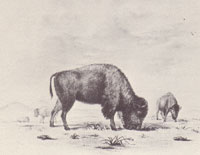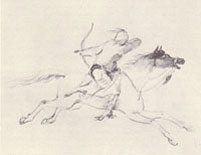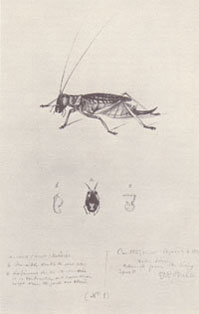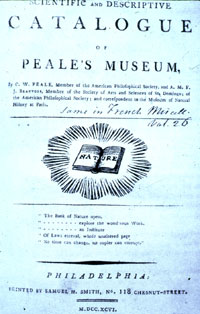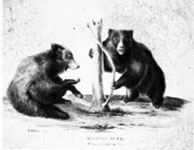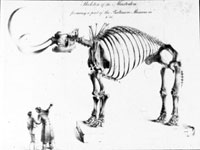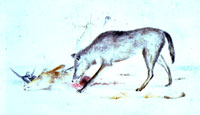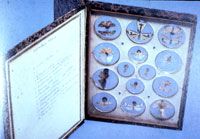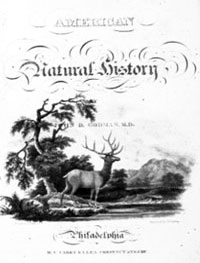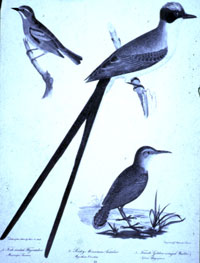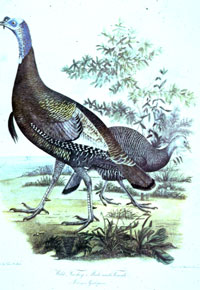On Christmas Day 1817, Titian Ramsay Peale (1799-1885), the seventeen-year-old son of Charles Willson Peale (1741-1827), noted painter and founder of the nation’s first museum, left Philadelphia with zoologist George Ord (1781-1866) and sailed to Savannah, Georgia.
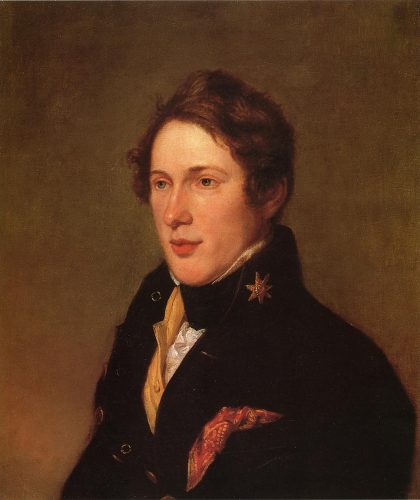
There, the two men joined the wealthy geologist William Maclure (1763-1840) and naturalist Thomas Say (1787-1834), whose pioneering work on American insects “the self-styled Dr. T. R. Peale” had begun to illustrate. All four, including young Titian, were officers of the newly organized Academy of Natural Sciences in Philadelphia. As Academy president, Maclure generously supported fieldwork, although exact scientific expectations for the trip to Florida remain unclear.1
According to Say, Maclure delayed until December 12, 1817, to invite him to follow in “the track of Bartram,” Say’s great-uncle William Bartram (1739-1823) whose well-known travels into East Florida had been published in 1791.2 Despite insights provided by Say’s correspondence at the Academy and Titian’s few letters home (now owned by the American Philosophical Society in Philadelphia), there appears to be no full narrative account of their trip other than Peale’s description.3
This trip to Florida established directions that Titian’s long and uneven career would follow. As an explorer, he accompanied Major Stephen H. Long’s expedition to the Rocky Mountains in 1819-20, collected birds again in Florida in 1824, traveled from Maine to Colombia from 1829-1832, and joined the first United States Exploring Expedition to the South Seas in 1838-42.
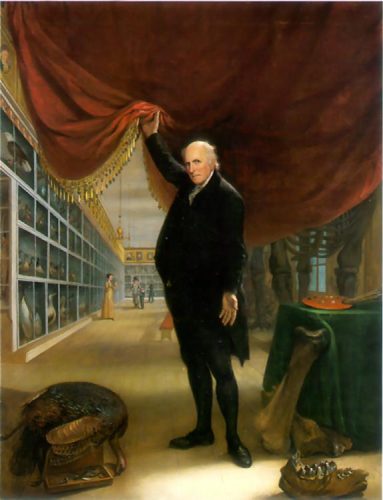
During intervals spent in Philadelphia following 1821, the young man managed his father’s Philadelphia Museum, drew insects for Thomas Say’s publications, and on the pages of the Academy’s Journal, introduced the process of lithography to North American scientific illustration. In addition, with the patronage of young Charles Lucien Bonaparte (1803-1857), Titian had by age of twenty-four established himself as the foremost bird illustrator in the United States prior to John James Audubon’s debut.
George Ord’s jealous protection of the ornithological press in Philadelphia forced Audubon to seek a publisher abroad and allowed Titian to continue successful work with Bonaparte on the handsome 4-volume American Ornithology, or the Natural History of Birds Inhabiting the United States and not Given by Wilson (Philadelphia, 1825), a work which included birds from Titian’s Florida explorations and western travels.4 In the next decade, Peale designed coins for the United States mint and printed the first and only part of his sumptuous work, Lepidoptera Americana: or Original Pictures of the Moths and Butterflies of North America (Philadelphia, 1833).
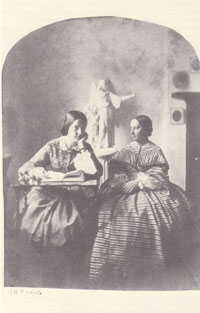 Titian’s career took a sharp turn during the 1840s. The family museum failed in Philadelphia, and the collections, including those made by Titian in Florida, were purchased by P. T. Barnum at auction.5 Titian’s wife and his daughter named Florida died, and he was unable to complete his official report for the U.S. Exploring Expedition.6
Titian’s career took a sharp turn during the 1840s. The family museum failed in Philadelphia, and the collections, including those made by Titian in Florida, were purchased by P. T. Barnum at auction.5 Titian’s wife and his daughter named Florida died, and he was unable to complete his official report for the U.S. Exploring Expedition.6
In 1849, the naturalist started a new life as examiner at the Patent Office in Washington, D. C., and he developed new hobbies-photography and oil painting.7 Although he continued to collect insects, Peale never regained the professional standing as a naturalist which he had enjoyed prior to 1842. After long government service, he died in Philadelphia in 1885. The American Museum of Natural History, New York, New York, owns a collection of his papers.
- Maclure, a Scottish-born businessman whose wealth made possible a life devoted to American geology and philanthropy; Say, an entomologist and first American to publish a paper on native species of mollusks in 1816; Ord, an affluent ship chandler and editor in 1815 of the best early systematic account of North American mammals.
- Thomas Say to John F. Melsheimer, December 12, 1817, in W. J. Fox. “Letters from Thomas Say to John F. Melsheimer. 1816-1825,” Entomological News and Proceedings of the Entomological Section of the Academy of Natural Sciences, XII (1901), 233. William Bartram’s 1773-1777 trip was published as Travels through North and South Carolina, Georgia, East and West Florida (Philadelphia, 1791).
- Jessie Poesch, Titian Ramsay Peale, 1799-1885 (Philadelphia, 1961) includes selected passages with an itinerary.
- See also Francis Hobart Herrick, Audubon the Naturalist, 2 vols. (New York, 1917), I, 327-46, and Robert Henry Welker, Birds and Men (New York, 1966), 62.
- Charles Coleman Sellers, Mr. Peale’s Museum (New York, 1980), 307-35.
- Titian’s troubles have been discussed by Poesch, Titian Ramsay Peale, 94-103, and Charlotte M. Porter, “Subsilentio: Discouraged Works of Early Nineteenth-Century American Natural History,” Journal of the Society for the Bibliography of Natural History, IX (April 1979), 109.19.
- For catalogue of his photographs owned by the American Philosophical Society, Philadelphia, PA and the American Museum of Natural History, New York, NY, see Julie Link Haifly. Titian Ramsay Peale, 1799-1885 (Washington, 1981).
Following Bartram’s “Track”: Titian Ramsay Peale’s Florida Journey
by Charlotte M. Porter
This article was originally published in the Florida Historical Quarterly 61 (April 1983): 431-444.
On “Christmas Day 1817, Titian Ramsay Peale (1799-1885), the seventeen-year-old son of Charles Willson Peale (1741-1827), noted painter and founder of the nation’s first museum, left Philadelphia with zoologist George Ord (1781-1866) and sailed to Savannah, Georgia. There, the two men joined the wealthy geologist William Maclure (1763-1840) and naturalist Thomas Say (1787-1834), whose pioneering work on American insects “the self-styled Dr. T. R. Peale” had begun to illustrate. In Savannah, Georgia, William Maclure sold his carriage and horses which had followed him overland, chartered a thirty-ton sloop, and procured supplies. Meanwhile, George Ord and Titian Ramsay Peale, an enthusiastic marksman, went hunting with Ord’s hounds in the Georgia woods. The party of eight, which included three hired sailors and Maclure’s servant, visited the Georgia Sea Islands and the town of St. Marys, where they procured provisions before sailing up the St. Johns River. At this point, Thomas Say wrote rather naively: “we entertain no fears from hostility of the Indians, we could even repell the attack of a few of them.”
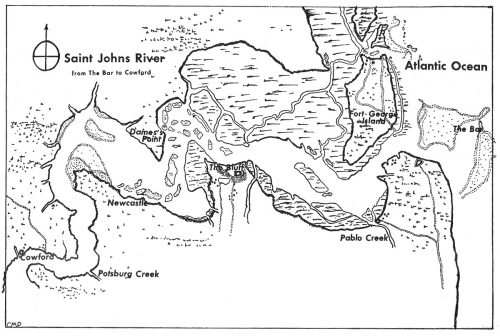
Although the Treaty of Paris had returned Florida to Spain in 1783, Spain was unable to police the runaway slaves, renegade Indians, and pirates or to protect East Florida waterways, and the United States government received many protests of disorder on the Florida frontier. On December 23, 1817, just two days before the naturalists’ departure, a naval squadron sailed into the Amelia River near Fernandina on the northeast coast of Florida. Two hundred troops landed, but as the naturalists were to discover, this American presence did not allay Native American hostilities on the peninsula or safeguard inland travel. Why the naturalists were in Florida at this time is another question. Throughout his long life, Maclure had the uncanny ability of being present at political hotspots under the banner of science.
Once in Florida, Peale, Ord, and Say had to verify their passports to Spanish authorities. They left Maclure at Fort Picolata near the mouth of the St. Johns River and made their way along the swampy King’s Road to the residence of the Spanish governor, Jose? Coppinger, at the old city of St. Augustine. After learning that raids made further venture up the St. Johns River imprudent, according to Say’s correspondence, the party back-tracked with hopes of exploring the Mosquito River, an area illustrated in the map published with Bartram’s Travels. Once more thwarted by reports of dangerous Indians, they decided to investigate the upper reaches of the St. Johns River. Near Fort Picolata, however, they met a plantation owner whose son had been recently murdered by Indians. Say wrote, “we departed from that place in good time as it seems probable they went in quest of us.” Ord left the party at St. Marys; the others proceeded
North collecting along the Sea Islands to Savannah, where they disposed of the sloop. Maclure, who suffered violent seasickness, returned to Charleston by steamboat, while Peale and Say sailed home on the Rambler. The naturalists reconvened in Philadelphia at the end of April of 1818. A disappointed Say concluded: “Thus, in consequence of this most cruel & inhumane war that our government is unrighteously & unconstitutionally waging against these poor wretches whom we call savages, our voyage of discovery was rendered abortive.”
Surprisingly, Peale’s account does not mention the dangers which compromised the trip’s complete success. In contrast to the older travelers, he seems to have enjoyed the dangers as adventure. Say described him contentedly “sitting by our cabin fire (though it is not so cold as to need one) reading Bartram’s Travels.” In addition to Amerindian antiquities and zoological specimens, Titian Peale returned to his father’s museum with several South American birds sent by the manager of the Charleston Museum in Charlestown, South Carolina.
The undated account of the Florida trip was written down by L. Peale, possibly Titian’s grandson Lincoln or his second wife Lucy. The orthography of the original manuscript in the collection of Titian Ramsay Peale Papers owned by the Library of the American Museum of Natural History in New York, New York, has been retained throughout. Crossed-out sections have been reinstated for historical interest.
Click here to download a PDF version of the article
Transcription of an account by Titian Ramsay Peale of a collecting expedition to Florida and Georgia sponsored by the Academy of Natural Sciences, Dec. 1817-April 1818. The expedition party included William Maclure, Thomas Say, George Ord and Titian Ramsay Peale. View a scan of the original manuscript here.
In the year 1817 a Scientific party was formed by Mr. Wm McClure, a geologist of Philadelphia, to visit Florida while it was yet a Spanish possession. His associates were Mr. Thomas Say Entomologist, Mr George Ord, and Mr Titian R. Peale Ornithologist.
Mr Ord and Mr Peale, then quite young, left Philadelphia December 25th 1817, in the usual sailing vessel for Savannah, where they were to join Mr Mcclure and Mr Say. At Savannah Mr Geo Summers hearing of Mr Peale’s arrival called upon him Immediately and guided them to all places of interest in the city and surroundings.
Mr Oemler, noted for his zeal in Entomology and Botany, came to see them also.12 These gentlemen made the time pass most pleasantly, while waiting for the rest of the party. Walking with them one day, they accidentally met Mr Say who had arrived the night before in a steamboat from Charleston. He conducted them to Mr. Mcclure-all delighted to meet and eager for the trip.
While Mr McClure, the businessman of the party-having gotten it up-was engaging a vessel and laying in stores, Mr Ord and Mr Peale made good use of their time, hunting in the nighborhood, and getting many birds, which Mr. Peale preserved, and left with Mr Oemler until their return.
On leaving the city the Merchants and Planters sent them Inters to every Island along the coast of Georgia. Having learned their route, they also sent word to their friends, to offer every facility to the party. This intended kindness, proved a great anoyance, for at every place they approached, invitations were sent them to come and visit: Mr McClure invariably answered that they were on a trip that did not admit of visiting and that they were only equipped for what they had to do.
The sloop they had engaged held besides the four Scientists three sailors and Mr. McClure’s servant. They landed at Great Warsaw island, and began shooting, to the great alarm of the inhabitants, who arned themselves with all possible speed, thinking they were outlawed negroes shooting their cattle.13 Mr. Peale shot here among other things, a large Baldhead Eagle. At Ossabau island, he got the large Crow-blackbird (Greakle) for the first time and was delighted with the bird-shortly after Mr Ord shot another.14
They were charmed with Blackbird island, on which they landed.15 The interior was covered with beautiful groves of live Oak, and abounded with Deer, that fed on the acorns. On its banks were immense sand hills, giving fine effect to the rich, glossy dark green foliage of the live Oak. The waters of the inlet were filled with multitudes of beautiful Medusae and other Molluscous animals, their phosphoric light giving brilliancy to the waters-and adding zest to their evenings,-which closed the days crowded with enjoyment, from their various and numerous collections.
They landed on the north end of Cumberland island and went into the interior to hunt Deer.16 As they were sailing around the island they got aground, and the people sent a pilot to them (though they had one on board) and insisted on their coming on shore. Finding their vessel fast in the sand, at nearly high tide, and knowing that as the waters receded the vessel would be on her beam ends so that they could not stand upright on deck they accepted the invitation.
They were taken first to Mrs. St Simons’s, by whom they were hospitably entertained, and were thence to visit Mr & Mrs Shaw at the celebrated Mansion built by Gen Greene of Revolutionary fame-a perfect castle in dimensions-but most singular in effect, being built of concrete made of oyster shells put into a box of the intended thickness of the walls, with plaster poured in and let stand until hard.17 The house was thus gradually made, forming a most substantial dwelling.
The walls being very thick, took a long while to make, especially with the slow slave labour, and getting impatient, they used it without plastering the interior as was the custom. The effect was, of course, incongruous-almost ludicrous. Sitting in the vast Hall in which they dined-on elegant imported furniture, at a most sumptuous table, they saw, when they looked up oyster shells sticking out of the walls in every direction, in strange contrast to the elegant hospitality below.
The garden and grounds seemed quite a paradise with hedges formed of Lemon, groves of Orange trees, roses and other flowers in full bloom, though it was January. From the top of the house they had a view of Amelia island, the Sea and the Mainland at the same time, forming a magnificent view, Mr Shaw was a most courteous host. With the usual southern habit, a negro was assigned to each one immediately on their arrival.18 Mrs. Shaw daughter of Gen. Greene, was a lady of great intelligence and cultivation, well fitted to dispense the refined hospitalities of her luxurious and most beautiful home.
Mr Peale saw here a painting of Sully’s, a copy S die likeness of Gen. Greene by his father, Chas. W. Peale who was the only one who painted the General from life.19 Their vessel being in readiness next day, they took leave of Mr. Shaw ad family-having enjoyed their improvised visit to the utmost. Passing in front of Fernandina, they saw at anchor the United States Squadron consisting of the John Adams, Saranac, Prometheus and other smaller vessels, and reached St Mary’s in the afternoon.
Mr McClure and Say went ashore, Mr Ord and Mr Peale preferred remaining on board, Though it rained all the ant day the Lieut-Governor of East Florida came on board in the morning and offered any service in his power. Continued rains detained the party at St Marys, but on the third of February they sailed for Fernandina-which they found half deserted ad the inhabitants of the other half almost in a state of starvation. None of the houses were more than two stories high.
They visited the grave yard, if it might be called one, just out of the suburbs of the town. According to Spanish custom every grave had its cross at the head (This is not peculiar to Spaniards)-if it were but a stick split; another placed in its crosswise and both lashed together with an old suspender. There seemed to have been great mortality-helped no doubt by “Patriot” knives. For the attention of the Fillibusters of that day having been turned wards Florida, they had taken possession of Amelia island, under the name of Patriots–which they professed to be, and threatening to release the country from Spanish rule, had gone even to the gates of St Augustine, not more than six months before.
At that time, tracks of Deer were found within half a mile of the town.
One of the many Medusae lying on the shore was to be two feet in diameter, and on entering St John’s river numbers of Porpoises were seen. The next day the party thirty miles up the river seeing among various other birds, Fishing Pelicans and Whooping Cranes.20 They anchored opposite the plantation of a Mr Richards on the west side of the river where they got a little Egret (Snowy Heron.)21
They up the river to Cowford, delivered their letters-and soon finding it a miserable place, of but a few huts and the half of them without roofs or inhabitants. Reporting the vessel, they sled along the river, found the clay bluff well timbered with Pine, Live Oak, Bay Laurel (Magnolia Grandiflora) and various otheer trees. Along the banks were a few plantations, many of them deserted or burned. They landed on one that belonged to Mr Craig of Savannah and saw here the finest grove of Oranges they had yet met with-upwards of five hundred trees, many of them almost breaking with thier load of fruit.
The river was tout four miles wide and the water quite fresh. The next day having a fair wind that blew almost a gale they reached for Picolata, which they found in ruins. They hunted all day without seeing anyone, until near night when two countrymen came along; hearing the guns they came to see who fired them. From them they learned that, that was the nearest point to St Augustine-whither it was determined to go next day to report themselves and present their Pasport-one of these men having been engaged as guide.
Mr McClure who was the author of the first work on Geology in the United States22 – wishing to visit Florida to study its formation, had doubted whether he would be allowed to go on account of constant inroads from the north and on applying to the Spanish Consul in Philadelphia for a passport was told that he had no authority, but would write to Spain about it: The answer was a royal pasport for Mr McClure and party.23
Armed with this, he organized his small expedition-but now shrank from presenting it, on account of the twenty three miles it was necessary to go, through a country entirely unprovided with accommodations of any kind. The rest of the gentlemen however undertook to do it, starting immediately after breakfast, Mr McClure remaining in the sloop.
They passed through Pine barrens and Swamps, frequently up to their middle in water, the whole twenty three miles, and saw no vestige of habitation nor a single inhabitant. They arrived at the gates of the city about sundown and were obliged to enter in this soiled condition to the Governor’s house, which consisted of two stories, the first containing the offices and the Guardhouse, into which they were shown.
In the second were the private apartments of the Governor who chanced to be entertaining two British Officers that day, and the attendant-no doubt-when he announced that some strangers sought audience, represented that they were travellers of little consideration judging from their apperance-as he continued at dinner, leaving the gentlemen in the guard room, their impatience not being lessened by the sound of enjoyment reaching them from above. After awhile Gov. Coppinger (afterwards Coy. Gen. of Cuba)24 sent for them, and they were ushered, in their soiled travel garments, into the convivial ball, where the guests were still seated.
The Governor, probably annoyed by the interruption, from such unattractive visitors, haughtily demanded their business while his guests looked patronizingly on them as they stood there. When the passport was handed him, the effect was magical. As soon as he saw the royal seal and signature, he exclaimed “from the King!” and was completely astounded, rising immediately and bowing low with many apologies for their detention he urged them to sit at dinner-which they declined-but as he insisted on their taking wine with him, they consented.
He was profuse in his offers to serve them bowing low all the time, as did every one-following his example guests and all. They told him all they wanted was lodgings that they might retire to, and get rid of the load of soil the unusual travel had laden them with, and make comfortable for the night. Immediately persons were sent different directions, but no quarters could be found-until British officers said, at their boarding house they might possibly be accommodated and sending, they got room for the party.
After calling next day on the Governor-whom they found such beloved by the people-they returned to the vessel, ailing on, anchored in an eastern branch of the St John’s and landed on a plantation, just deserted, where they hunted some time with very great success. Landing again the next morning they shot as many Partridges as they wanted before breakfast. They then went ashore to dig at an Indian mound in middle of a neighbouring plain. It was 90 ft in circumference 9 or 10 ft high.
They dug about 7 ft in the centre of it-three flint spear heads, a stone hatchet, a copper rod at both ends, and a large Conch shell of a species that is not on the coast of America and is probably extinct-also some lumps of red paint.25 They sailed within the Sea Islands landing at various plantations, generally deserted-gathering specimens many kinds-of birds &c-until they came to Pablo Creek where they hunted in the canoe.26 Mr McClure and Mr Say went up the Creek to a plantation, to get information and found from the jealousy of the Spaniards they would be unable to go further south.
They therefore contented themselves with coasting the St John’s river. The next morning Mr Peale shot a very fine white Pelican, and prepared it the following day, it weighed eighteen pounds. They hunted also on North Beach and from the north end of Fort George island where there is a high range of hills covered with Live Oak, they enjoyed the finest prospect they had ever seen in Florida,-a wide expanse of Sea, besides the nearer islands, lakes and lagoons. Another fine view was enjoyed from St John’s Bluff the highest front of land yet seen.27
It was here the town of St John was have to been built. nothing however was to be seen but two poor huts. After cruising to anchor next day at the mouth of a creek just below Cowford. Mr Say and Mr Peale proceeded up the creek in a boat, and about two miles up found the nest of an Alligator. It was in a marsh about six feet from the water-3 ft high and 4 in diameter-the eggs about the centre. Next day went up another branch of the river, saw numbers of alligators.
They continued coasting for some day and they sailed for Ft Picolata where they arrived about noon. Mr Peale made a drawing of the fort. The next morning they set out with Wantou their Guide-(whom they had kept with them) to St Augustine to hunt, had not been out long when they shot: fine Buck, and wounded three others, also a large male squirrel and saw a Black Wolf, but did not get a shot at it,28 returned to get dog, to hunt the wounded Deer-Mr Ord having brought his dogs with him.
They found among the several modes of hunting Deer the people there practiced is one they call fire hunting which is done at night. The hunter has a wallet slung on his back filled with Pine knots or light wood, and a frying pan on his shoulder on which he mades a fire, the wood in the wallet is to feed it. Thus equipped he walks through the haunts of the fleer. At sight of the fire they stand still and look at it, their eyes reflect the light strongly which makes the hunters mark who rarely misses. If only wounded they hunted the next day with dogs.
The party sailed from Picolata down the river. On wednesday after coming to anchor at the mouth of Pottsburgh Creek, Mr Ord and Mr Peale ascended in the canoe several miles, stopping at a plantation and dining on Parakeets-which they saw in great numhers.29 Going up the creek Mr Peale shot an alligator in the head with a ball, cut its throat and laid it on its back on the hank-coming back in the evening it had so far recovered life as to turn itself, and run in the marsh some distance.
He fired another ball into its head, and took it on board the vessel alive! It was 8 ft 4½ inches long. At night they harpooned fish by fire light. They sailed early the next day, and long after dark came to anchor off St Johns Bluff, in the morning heard the roar of alligators for the first time and sailing again anchored near the mouth of the river, Mr Ord and Mr Peale spent the day in the canoe hunting Pelican.
The next day going off again at day break, they surprised at the great quantity of Medusae cast on the shore. It was indeed immense. They estimated that in one place for half a mile the ground was completely hidden by them.30
Mr McClure not wishing to go to sea again, concluded to go to Amelia island in a boat that was ready to go, & Mr Say accompanied him.
Mr. Peale sunk a barrel in the sand to shoot Pelican from, Mr Ord in the meantime was fishing and caught sixteen Sheep’s Head of from seven to eight pounds each.31 The equinoctial storm coming, they were obliged to run up the river several miles for a harbor. When the storm abated they sailed down the Beach, saw but a few marine animals, and went in among the ponds in the interior of the sand hills hunting ducks.
They amused themselves for some time with the Porpoises, their young at this season being about a foot and a half long, they carry them on their pectoral fins and are sometimes seen with them in their mouths. They frequently saw Porpoises with Medusa in their mouths, but whether they ate-or only played with them could not tell. In the evening they saw several flocks of Snowy Herons, flying north among them were a number of ashcolored Herons. After cruising about for several days, with great success, they crossed the bar and in a short time bade adieu to St John’s river.32
Immediately after they crossed the bar the wind shifted to N.W. and g directly ahead, drove them out to sea and left them in a calm rolling sea, both becoming very sea sick and wishing they back in St John’s river-but wishing was of no avail, for they drifted out of sight of land, and were benighted and becalmed the same time. The next day they came in sight of Amelia island, and the wind rising from N.E. soon ran in and came to anchor off Fernandina about ten 0 Clock-not finding Mr McClure and Say here-and learning they had gone to St Marys, sailed for that place at change of tide and arrived before night.
Found Mr McClure and Say anxiously awaiting their arrival. Mr. Ord too, was getting uneasy about his business at home and took passage in a vessel that was to sail at twelve next day-the day after at sunrise the other gentlemen sailed in their sloop from St Mary’s and came to anchor at the south end of Cumberland island. They visited the Shaw family-then sailed before noon, and reached little Cumberland island before night. They cruised among the islands, visiting those they had been at before, and making acquaintance with those they had passed in going up the Altamaha to Darien-making collections everywhere.
On arriving at Savannah they found a great change, whole rows of stores and houses were going up-some of the latter were built of “Tabby” a composition of oyster shells, lime & sand, cast in mould-the same as “Dunginnes” the residence of the Shaws on Cumberland island.33 They tried to get a pilot for the islands between Savannah and Charleston, but failed. Mr McClure decided to go in the steamboat, and the two other gentlemen by sea, in the Rambler, a sailing vessel. Both left early next morning and reach Charleston in the afternoon of the second day. They left Charleston 16 of April.
Florida being a new field gave great delight to the explorers- who with their small vessel thoroughly searched its streams, shores, and swamps, for products of their different branches of science-in all of which, they made large collections, and spent a most enjoyable and delightful winter.
L. Peale
Soon after they turned their faces towards the north, and arrived safely at home, enriched with abundant collections in their several departments and having enjoyed immensely their winter trip to Florida.
As you travel, enjoy these images in museums throughout the United States.
